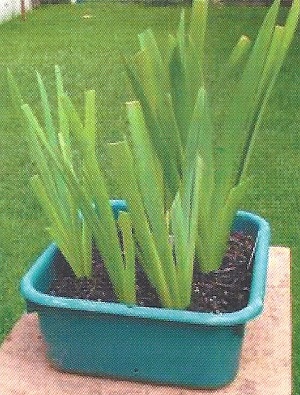One of the remarkable attributes of the Louisiana iris is its ability to grow in regular garden soil-or in a swamp. It is one iris that will absolutely thrive in containers. Watering is more easily controlled, and thus, growing in pots can be a major consideration in a water- starved area.
Everyone who has ever potted up a rhizome and then let it set for a year, or two, or even three, knows that Louisiana irises have a rugged will to live, even to prosper. This iris is clearly suited to pot culture.

As many of my fellow gardeners seem to be getting older, I suspect pot culture will have certain things to recommend it. Watering potted Louisianas is a snap. Weeding is also fairly easily done. However, there is a wicked downside to this theme, and that is the bald truth that these potted irises soon become a matted mass of rhizomes and roots-which can be awfully difficult to un-pot. Of course, you can always wait an extra year and let the crowed rhizomes break open the pots!
Over the past few months several digital photos have been sent me of Louisiana irises growing in containers. Some of these were posted on the “Lairis” discussion group (actually a listserv) on the Internet.
Many pictures came from members at the national convention in Tucson, Arizona in April. It was good for us to see that people all over that desert city are growing Louisiana irises in pots and tubs and lined beds. One good example from the convention tour gardens was the garden of Bert Detwiler, a long time member of SLI. The accompanying photograph shows merely one of many areas where Bert managed to have a wonder bloom.
Here’s how Jim Linder of Texas describes his experience with bucket gardening: “I started using the five gallon plastic buckets for Louisianas maybe six or eight years ago, probably because they were available and the price was right (like free). I worked at the Sherwin Williams Paint Store and could get plenty of used buckets. I use a combination of potting soil, sand, perlite, gravel, slow release fertilizer, and soil from the yard, filing the buckets about two/thirds full. Then plant the rhizome and fill the bucket with water. I keep them wet but not necessarily full of water. The plants have to be re-potted each year as they may actually crack and break the plastic buckets during the second year from overcrowding.”
Dr. T. John Betts, a leading breeder of Louisiana irises in Australia, reports success in using “washing-up bowls” as containers for Louisiana irises. Note that he comments on the usefulness of pot culture in fighting nematodes and probably other pests:

”For some time, I have grown them in plastic washing-up bowls, success- fully enough to win the West Australian State Championship for Iris in 2003. My wife invented this method, and my picture shows autumn growth in a bowl. The two drainage holes are bored in the side just above the base (one can be seen) so that with normal watering there is a swampy bottom to the potting mix content, and the roots grow round and round this. The bowl does not need to be full to the brim with soil. Each bowl will take three rhizomes, which I feed with sustained release granules in autumn, then ‘camellia fertilizer’periodica1ly, and soluble mix from early spring. This method avoids difficulties such as nematodes or other problems of garden soil, and allows the bowls to be carried around to be placed beneath a window for viewing from inside when they can carry three or more bloom stalks. They should need splitting/rebowling each summer, but the plants are easily tipped out for this. Bargain-priced bowls can be found, avoiding bright colours like red or yel- low which look unsightly and deteriorate quickly with garden exposure, al- though they all crack-up eventually.”
*Tom Dillard, a long time gardener, is the former secretary of the Society for Louisiana Irises (SLI) and the former editor of the SLI Newsletter and of the Fleur de Lis, the quarterly publication of SLI. He is now retired and lives in Malvern, AR, just south of Little Rock, AR.
This article first appeared in the SLI Newsletter in the Fall 2005 issue.



